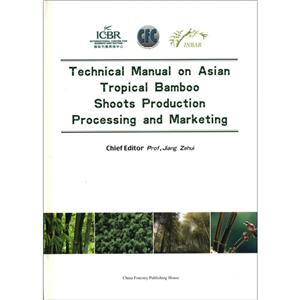预估到手价是按参与促销活动、以最优惠的购买方案计算出的价格(不含优惠券部分),仅供参考,未必等同于实际到手价。
-
>
通宵俱乐部-签名本
-
>
2022读者节纪念徽章-一星会员专属
-
>
20世纪中国短篇小说选集(全6册)(八五品)
-
>
(精)方力钧作品图录
-
>
“囤书者说”藏书印章系列-谢绝外借
-
>
(精)赵丹书画选
-
>
中图网文创礼包-“民国名家画谱”藏书票贴纸(2张)
亚洲热带竹笋培育生产加工销售技术手册:英文 版权信息
- ISBN:9787503859922
- 条形码:9787503859922 ; 978-7-5038-5992-2
- 装帧:暂无
- 册数:暂无
- 重量:暂无
- 所属分类:
亚洲热带竹笋培育生产加工销售技术手册:英文 内容简介
本书汇集了当前笋用竹培育、竹笋生产加工和销售先进实用技术, 体现了科学性和实用性的统一。
亚洲热带竹笋培育生产加工销售技术手册:英文 目录
1Distribution of Bamboo Resources
1.1B amboo Resources in the World
1.1.1Asia and Pacific Bamboo Region
1.1.2 America Bamboo Region
1.1.3 Africa Bamboo Region
1.1.4 Europe and North America Introduced Region
1.2 Bamboo Resourcesin Cruna
1.2.1 Bamboo Region between Yellow River and Yangtze River
1.2.2 Bamboo Region between Yangtze River and Nanling Range
1.2.3 Bamboo Region in South China
1.2.4 Bamboo Region in High Mountainous Regionin Southwest China
2 Biological Basis in Tropic Bamboo Cultivation
2.1 Characteristics and Functions
2.1.1 Nutritious Components
2.1.2 Reproductive Organ
2.2 Growth Characteristics
2.3 Growth and Environment
3 Nursery Techniques of Sympodial Bamboo
3.1 Nursery Site Preparatio
3.2 NurserySeason
3.3 NurseryTechniques
3.3.1 Raising with Seeds
3.3.2 Raising With Branch Cutting
3.3.3 Raising with Buried Culms
3.3.4 GroundLayering
3.4 NurseryManagement
4 Afforestation Techniques of Sympodial Bamboo Shoot Stands
4.1Site Selection
4.2 Site Preparation
4.3 Planting Season
4.4 PlantingMethods
4.4.1 Afforestation with Transferred Mother Culms
4.4.2 Afforestation with Transferred Seedlings
4.4.3 Afforestation with Buried Internodes or Branch Cutting
4.4.4 Density of First Planting
5 Young Stands Cultivation Techniques of Tropical Bamboo Shoot
5.1 WaterManagement
5.2 Intercropping
5.3 Weeding and Soil-loosening
5.4 Fertilizing
5.5 Keeping Shoots and Protecting Bamboos
5.6 Pest and Disease Control
5.7 Damage by wild animals and their control
6 Effiaent Tending Techniques of Sympodial Bamboo Shoot Stands
6.1 Soiland Fertilizer Management
6.1.1Raking to dry in the sun
6.1.2 Fertilizing
6.1.3 Shoot Cultivating
6.1.4 Irrigating
6.1.5 Intertilling and Weeding
6.2 Structure Adjustment
6.2.1 InterclumpDensity
6.2.2 InnerclumpDensity
6.2.3 Age Structure of Mother Culms
6.3 Technique of Shoot Harvesting and Culm Retaining
7 Cultivation Techniques of Major Sympodial Bamboo Shoot Speaes
7.1 Dendrocalamus latiflorus Munro
7.1.1 NurseryTechruques
7.1.2 AfforestationTechniques
7.1.3 Management of Young Stands
7.1.4 Management of Mature Stand
7.2 Dendrocalamus oldhami (Munro) Keng f
7.2.1 NurseryTechniques
7.2.2 Afforestation Techniques
7.2.3 Nursery ofYoung Stands
7.2.4 Management of Mature Stands
Chapter 2 Bamboo tissue culture
Introduction
1Protocol for Sympodial Bamboo Tissue Culture
……
Chapter 3 Bamboo shoots processing packaging and marketing
亚洲热带竹笋培育生产加工销售技术手册:英文 节选
Bamboo is considered as belonging to the group of geophytes due to the monocarpic pattern of its development. The unique flowering behavior of the most economically important species and the short period of viability seeds mean that the natural means of propagation cannot be depended upon totally. Vegetative propagation in bamboo has been traditionally practiced in different parts of the world. When carried out in propagation units with use of hormones, it can be successfully used for large-scale propagation. A problem in large-scale multiplication is the limitation imposed by availability of plant material. For example,in the method that requires two-node culm cuttings, the number of such cuttings that can be taken from a clump is limited to a few dozens. The large size of the propagules produced by this method is also a limitation in handling and transport over long distances. Tissue culture, an efficient propagation method suitable for large-scale production of planting stock plays an important role in efforts to improve the natural resources of bamboo as in many other plant species. The potential for high rates of multiplication is the greatest advantage of micro propagation (Nadgir et al., 1984; Prutpongse et al., 1991a, 1992b) . Production of uniform, disease free plantlets all throughout the year is the other advantage. Tissue culture involves the growth and multiplication of cells, tissues, organs or whole plants on a synthetic nutrient medium under sterile and controlled conditions. The nutrient medium consists not only of a combination of mineral salts, vitamins and sugar which is essential for plant growth but also various types of plant growth regulators (hormones) in different combinations and concentrations depending on the type of culture and the plant. How to do bamboo tissue culture is summarized in details as follow. 1 Protocol for Sympodial Bamboo Tissue Culture Sympodial bamboo is non-invasive bamboo which grows best in tropical or subtropical climates. Usually thizome with roots, thizome with culm and roots and thizome with offsets are recommended for sympodial bamboo propagation. However, those traditional methods are not suitable when large-scale bamboo propagation is the objective. Tissue culture is the ideal way to be selected. Bamboo fast propagation is achieved by tissue culture (Banik, 1991; Zhang et al., 1993; Zhang et al., 2003; Yuan et al., 2009) . Vegetative parts of young or mature bamboo, such as embryo, culm buds, shoot buds and apical meristem, are induced to produce shoots and roots directly without help of callus. A Young bamboo is that its physiological age is less than ten years (from the time when the seed germinates to the time when the bamboo is obtained). Mature bamboo is that its physiological age is at least twenty- five years. 1.1 Selection of Explants Explants selected for bamboo tissue culture should have neotenous features (juvenile traits). Since seeds are difficult to obtain for many species, culm buds, shoot buds and apical meristem are often used as explants. Materials from young bamboo are better than those from older plants. Experiment on cutting culture with annual shoots that have just stopped growing during two-year-old and twenty-year-old Dendrocalamus latl[lorus showed that induction rate was 90% and 30% respectively. ……
- >
人文阅读与收藏·良友文学丛书:一天的工作
人文阅读与收藏·良友文学丛书:一天的工作
¥16.0¥45.8 - >
中国历史的瞬间
中国历史的瞬间
¥23.5¥38.0 - >
月亮与六便士
月亮与六便士
¥13.4¥42.0 - >
推拿
推拿
¥12.2¥32.0 - >
史学评论
史学评论
¥18.5¥42.0 - >
经典常谈
经典常谈
¥25.9¥39.8 - >
名家带你读鲁迅:朝花夕拾
名家带你读鲁迅:朝花夕拾
¥10.5¥21.0 - >
随园食单
随园食单
¥20.6¥48.0
-
2022图书×抽奖盲袋
¥9.9¥25 -
2023读书月阅读盲盒——天黑,闭眼,刀谁?
¥42.3¥158 -
2022读者节纪念徽章-三星会员专属
¥45¥45.6 -
2023读书月阅读盲盒——我什么场面没见过?
¥42.3¥158 -
2023读书月阅读盲盒——去码头整点什么薯条?
¥42.3¥158















